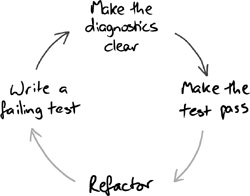Chapter 23. Test Diagnostics
Mistakes are the portals of discovery.
—James Joyce
Design to Fail
The point of a test is not to pass but to fail. We want the production code to pass its tests, but we also want the tests to detect and report any errors that do exist. A “failing” test has actually succeeded at the job it was designed to do. Even unexpected test failures, in an area unrelated to where we are working, can be valuable because they reveal implicit relationships in the code that we hadn’t noticed.
One situation we want to avoid, however, is when we can’t diagnose a test failure that has happened. The last thing we should have to do is crack open the debugger and step through the tested code to find the point of disagreement. At a minimum, it suggests that our tests don’t yet express our requirements clearly enough. In the worst case, we can find ourselves in “debug hell,” with deadlines to meet but no idea of how long a fix will take. At this point, the temptation will be high to just delete the test—and lose our safety net.
We’ve learned the hard way to make tests fail informatively. If a failing test clearly explains what has failed and why, we can quickly diagnose and correct the code. Then, we can get on with the next task.
Chapter 21 addressed the static readability of tests. This chapter describes some practices that we find helpful to make sure the tests give us the information we need at runtime.
Small, Focused, Well-Named Tests
The easiest way to improve diagnostics is to keep each test small and focused and give tests readable names, as described in Chapter 21. If a test is small, its name should tell us most of what we need to know about what has gone wrong.
Explanatory Assertion Messages
JUnit’s assertion methods all have a version in which the first parameter is a message to display when the assertion fails. From what we’ve seen, this feature is not used as often as it should be to make assertion failures more helpful.
For example, when this test fails:
![]()
the report does not make it obvious which of the assertions has failed:
ComparisonFailure: expected:<[16301]> but was:<[16103]>
The message is describing the symptom (the balance is 16103) rather than the cause (the outstanding balance calculation is wrong).
If we add a message to identify the value being asserted:
assertEquals("account id", "573242", customer.getAccountId());
assertEquals("outstanding balance", 16301, customer.getOustandingBalance());
we can immediately see what the point is:
ComparisonFailure: outstanding balance expected:<[16301]> but was:<[16103]>
Highlight Detail with Matchers
Developers can provide another level of diagnostic detail by using assertThat() with Hamcrest matchers. The Matcher API includes support for describing the value that mismatched, to help with understanding exactly what is different. For example, the instrument strike price assertion on page 252 generates this failure report:
![]()
which shows exactly which values are relevant.
Self-Describing Value
An alternative to adding detail to the assertion is to build the detail into values in the assertion. We can take this in the same spirit as the idea that comments are a hint that the code needs to be improved: if we have to add detail to an assertion, maybe that’s a hint that we could make the failure more obvious.
In the customer example above, we could improve the failure message by setting the account identifier in the test Customer to the self-describing value "a customer account id":
ComparisonFailure: expected:<[a customer account id]> but was:<[id not set]>
Now we don’t need to add an explanatory message, because the value itself explains its role.
We might be able to do more when we’re working with reference types. For example, in a test that has this setup:
Date startDate = new Date(1000);
Date endDate = new Date(2000);
the failure message reports that a payment date is wrong but doesn’t describe where the wrong value might have come from:
![]()
What we really want to know is the meaning of these dates. If we force the display string:

we get a message that describes the role that each date plays:
![]()
which makes it clear that we’ve assigned the wrong field to the payment date.1
1. This is yet another motivation for defining more domain types to hide the basic types in the language. As we discussed in “Domain Types Are Better Than Strings” (page 213), it gives us somewhere to hang useful behavior like this.
Obviously Canned Value
Sometimes, the values being checked can’t easily explain themselves. There’s not enough information in a char or int, for example. One option is to use improbable values that will be obviously different from the values we would expect in production. For an int, for example, we might use a negative value (if that doesn’t break the code) or Integer.MAX_VALUE (if it’s wildly out of range). Similarly, the original version of startDate in the previous example was an obviously canned value because nothing in the system dated back to 1970.
When a team develops conventions for common values, it can ensure that they stand out. The INVALID_ID at the end of the last chapter was three digits long; that would be very obviously wrong if real system identifiers were five digits and up.
Tracer Object
Sometimes we just want to check that an object is passed around by the code under test and routed to the appropriate collaborator. We can create a tracer object, a type of Obviously Canned Value, to represent this value. A tracer object is a dummy object that has no supported behavior of its own, except to describe its role when something fails. For example, this test:

might generate a failure report like this:

Notice that jMock can accept a name when creating a mock object that will be used in failure reporting. In fact, where there’s more than one mock object of the same type, jMock insists that they are named to avoid confusion (the default is to use the class name).
Tracer objects can be a useful design tool when TDD’ing a class. We sometimes use an empty interface to mark (and name) a domain concept and show how it’s used in a collaboration. Later, as we grow the code, we fill in the interface with methods to describe its behavior.
Explicitly Assert That Expectations Were Satisfied
A test that has both expectations and assertions can produce a confusing failure. In jMock and other mock object frameworks, the expectations are checked after the body of the test. If, for example, a collaboration doesn’t work properly and returns a wrong value, an assertion might fail before any expectations are checked. This would produce a failure report that shows, say, an incorrect calculation result rather than the missing collaboration that actually caused it.
In a few cases, then, it’s worth calling the assertIsSatisfied() method on the Mockery before any of the test assertions to get the right failure report:
context.assertIsSatisfied();
assertThat(result, equalTo(expectedResult));
This demonstrates why it is important to “Watch the Test Fail” (page 42). If you expect the test to fail because an expectation is not satisfied but a postcondition assertion fails instead, you will see that you should add an explicit call to assert that all expectations have been satisfied.
Diagnostics Are a First-Class Feature
Like everyone else, we find it easy to get carried away with the simple three-step TDD cycle: fail, pass, refactor. We’re making good progress and we know what the failures mean because we’ve just written the test. But nowadays, we try to follow the four-step TDD cycle (fail, report, pass, refactor) we described in Chapter 5, because that’s how we know we’ve understood the feature—and whoever has to change it in a month’s time will also understand it. Figure 23.1 shows again that we need to maintain the quality of the tests, as well as the production code.
Figure 23.1 Improve the diagnostics as part of the TDD cycle

